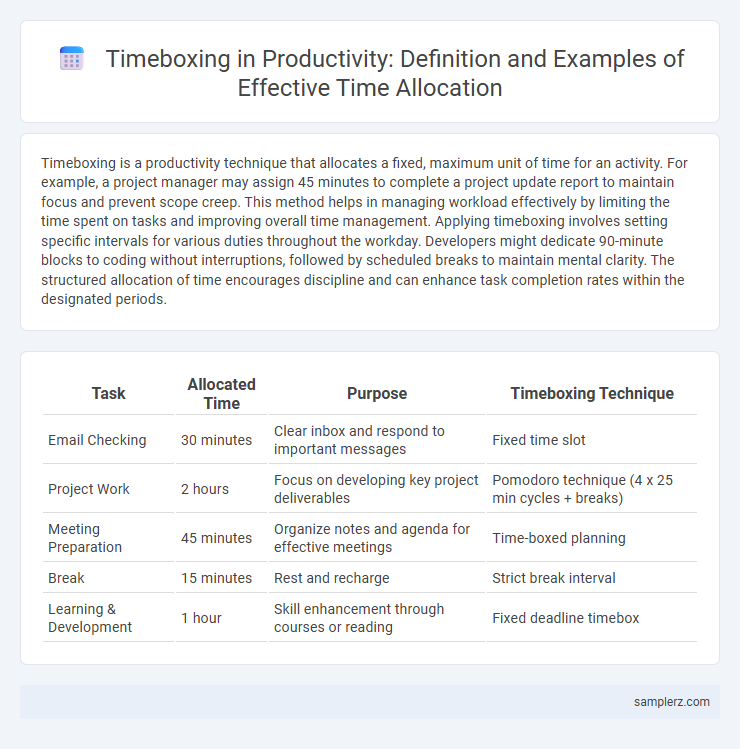Timeboxing is a productivity technique that allocates a fixed, maximum unit of time for an activity. For example, a project manager may assign 45 minutes to complete a project update report to maintain focus and prevent scope creep. This method helps in managing workload effectively by limiting the time spent on tasks and improving overall time management. Applying timeboxing involves setting specific intervals for various duties throughout the workday. Developers might dedicate 90-minute blocks to coding without interruptions, followed by scheduled breaks to maintain mental clarity. The structured allocation of time encourages discipline and can enhance task completion rates within the designated periods.
Table of Comparison
| Task | Allocated Time | Purpose | Timeboxing Technique |
|---|---|---|---|
| Email Checking | 30 minutes | Clear inbox and respond to important messages | Fixed time slot |
| Project Work | 2 hours | Focus on developing key project deliverables | Pomodoro technique (4 x 25 min cycles + breaks) |
| Meeting Preparation | 45 minutes | Organize notes and agenda for effective meetings | Time-boxed planning |
| Break | 15 minutes | Rest and recharge | Strict break interval |
| Learning & Development | 1 hour | Skill enhancement through courses or reading | Fixed deadline timebox |
Understanding Timeboxing in Productivity
Timeboxing in productivity allocates fixed time periods to specific tasks, enhancing focus and preventing overrun. By setting strict time limits, it encourages efficient work habits and reduces procrastination. This method leverages structured scheduling to promote disciplined task management and optimize overall productivity.
Key Benefits of Timeboxing for Task Allocation
Timeboxing enhances task allocation by setting fixed time periods for specific activities, which boosts focus and reduces procrastination. This method improves productivity by creating clear deadlines that prevent tasks from expanding indefinitely, ensuring efficient use of time. Key benefits include increased accountability, better prioritization, and a structured approach to managing workload effectively.
Timeboxing vs. Traditional Scheduling: A Quick Comparison
Timeboxing allocates fixed periods to tasks, enhancing focus and reducing procrastination compared to traditional scheduling, which often lacks strict time limits. This method prioritizes task completion within set intervals, promoting efficiency and preventing burnout. The contrast lies in timeboxing's structured approach, fostering discipline, whereas traditional schedules may lead to elastic task durations and fragmented attention.
Real-Life Timeboxing Examples in Project Management
Timeboxing in project management allocates fixed time periods to tasks, enhancing focus and efficiency. For instance, software development teams use timeboxing during sprint planning to ensure features are completed within set intervals, minimizing scope creep. Construction projects employ timeboxing for critical phases like inspections, ensuring deadlines are met and resources are optimized.
Using Timeboxing for Email and Communication Tasks
Timeboxing allocates a fixed, limited period specifically for email and communication tasks, minimizing interruptions and enhancing productivity. Setting 30-minute blocks twice daily confines checking, reading, and responding, preventing constant inbox monitoring. This focused approach reduces task-switching costs and ensures dedicated time for deep work on primary projects.
Timeboxing Creative Work: Brainstorming and Content Creation
Timeboxing creative work segments, such as dedicating 30-minute intervals for brainstorming sessions, enhances focus and generates diverse ideas efficiently. Allocating fixed blocks of time for content creation limits distractions and promotes sustained productivity by setting clear deadlines. This structured approach boosts output quality by encouraging deeper immersion within designated timeframes.
Applying Timeboxing to Daily Meetings and Standups
Applying timeboxing to daily meetings and standups enhances productivity by allocating a fixed 15-minute slot for each session, ensuring concise updates and avoiding unnecessary discussions. This method encourages participants to prepare key points in advance, maximizing focus and minimizing distractions. Consistent timeboxing promotes discipline, improves team alignment, and reduces meeting overruns significantly.
Effective Timeboxing for Learning and Skill Development
Effective timeboxing for learning and skill development involves allocating specific, uninterrupted time blocks dedicated solely to mastering new concepts or practicing skills. For instance, setting a 45-minute timebox each day for focused study of coding languages or professional certifications enhances concentration and retention. This structured approach minimizes distractions and promotes consistent progress by creating clear boundaries around learning tasks.
Timeboxing for Personal Goals and Self-Care Activities
Timeboxing enhances productivity by allocating fixed time periods for personal goals and self-care activities, ensuring dedicated focus and preventing burnout. Scheduling specific intervals for exercise, meditation, or hobby time increases consistency and helps maintain work-life balance. This structured approach reduces procrastination and fosters a disciplined routine, improving overall well-being and goal achievement.
Tools and Apps to Implement Timeboxing Effortlessly
Timeboxing enhances productivity by allocating fixed time slots for tasks, and tools like Toggl Plan, Focus Booster, and Microsoft To Do simplify this process through intuitive interfaces and automated reminders. These apps enable precise scheduling and track progress, ensuring adherence to predefined time limits and minimizing distractions. Integrating calendar synchronization and Pomodoro timers further optimizes focus and task management within daily workflows.

example of timeboxing in allocation Infographic
 samplerz.com
samplerz.com